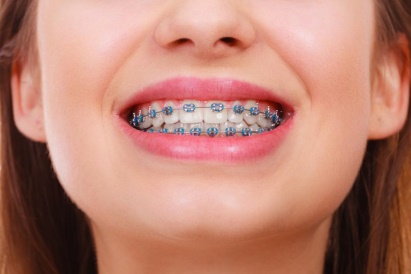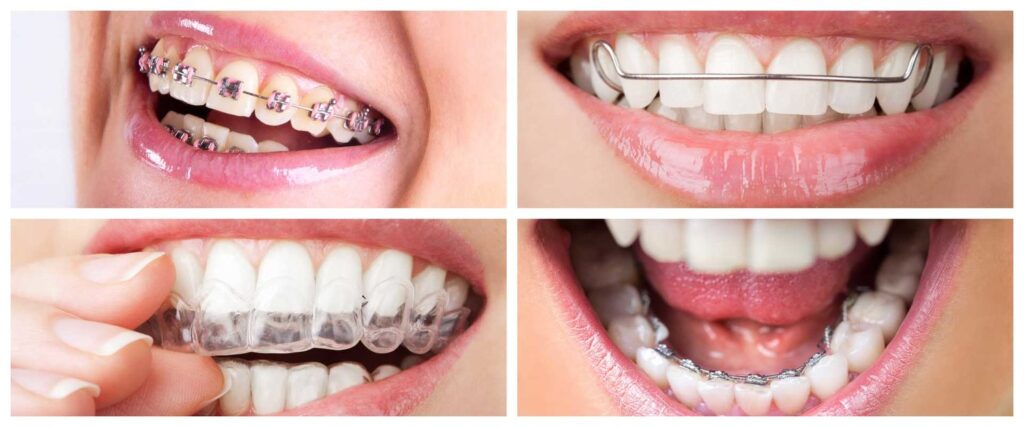Orthodontic braces correctly align and straighten teeth, assist in positioning teeth about a person’s bite, and improve oral health. Several types of braces are available, but they are commonly used to correct under bites, malocclusions, overbites, open bites, gaps, deep bites, cross bites, and crooked teeth, among other problems. Braces can be either cosmetic or structural.
TYPES OF DENTAL BRACES :
Traditional Metal Braces:
Traditional braces involve frames and wires, usually made out of metal, which is connected to the teeth and allows their positioning to be altered as needed. This type of brace is the least expensive, most effective, and most common of all braces today. The braces can be made to look more attractive using different colored bands over them, but they remain apparent.

Ceramic Braces:
Braces made of ceramic are similar to metal braces in size and shape, but they are constructed of a material that blends into the natural color of the teeth. It is just as effective as traditional braces at moving teeth into desired positions, but it is less noticeable due to its color, so it may be the better option for some.

Lingual Braces:
Traditional braces are made of metal, but lingual braces attach to the inside of the teeth, so they cannot be seen from the outside. They are also likely to be uncomfortable since they are directly in contact with the tongue. They are also more difficult to clean.

Invisalign:
Braces without brackets and wires are known as Invisalign, which appears as a series of clear plastic aligners worn over the teeth instead of brackets and wires.This type of braces is preferable for many patients because they are almost hidden and allow more significant freedom to eat and drink anything.

Self-Ligating Braces:
The effectiveness of these braces is similar to that of traditional metal braces, but they also may be more controlled, allowing for more precise alignment of the teeth. This leads to less friction on the braces and easier cleaning of the braces and teeth.

Procedure for Dental Braces:
An Orthodontist will first refer a patient to dental braces when concerns arise about the position of the teeth.
The duration of the treatment time type of braces needs to change for the patient.
Fitting of Dental Braces:
Once the dental braces are in place, the check retractor can be removed, and dental arch wires can be attached. The teeth should be polished well, conditioned, air-dried, and primed before the brackets are placed to ensure that the bonds form properly. A Dental cement holds the brackets in place on the teeth, exactly where there were determined during the initial dental examination. The complete arrangement procedure is moderately fast and typically takes quicker than 20 minutes.
Adjustment of Dental Braces:
The elastic links that hold the braces in place and arch wires are removed, and new links and wires are then placed. During each adjustment position, the action of teeth and progress so far with the dental braces should be evaluated, which permits one to make ongoing decisions. During this process, the teeth react to the pressure created by the braces and change position.
This is particularly valid when eating can be painful during this duration. There should be at least three weeks between each adjustment position to permit time for the teeth to proceed.
Removal of Dental Braces:
At the conclusion of therapy with dental braces when the teeth have been repositioned as expected, it is time to extract the braces. This method is relatively simple and not painful.
Once the brackets and the teeth have been cemented together, the bond should be gently broken by applying pressure to the brackets’ bases to squeeze them, which will release the adhesive bonds. The adhesive dental remains on the teeth so that the teeth and enamel are not damaged in the removal process..
It helps to support the new function of the teeth and enhance the retention period of the therapy.
Risks of Dental Braces
Soft Tissue Injuries:
The metal brackets and wires of braces can cause some sensitivity in the inner cheeks, lips, and gums of patients with braces. It is feasible to reduce pain and irritation in these places while helping the sensitive spots to heal with suitable care and treatment.
Allergic Reaction:
These materials can be avoided if there is a known allergy; however, if the patient experiences a reaction after the braces have been placed, the braces (or elastics) will need to be removed and replaced.
Loss of Correction:
Some patients may encounter a loss of modification of the teeth placed after the braces have been removed. This is most typical for patients who do not closely follow the orthodontist’s instructions for the aftercare of dental braces.
Advantages of Dental Braces:
Great Smile and Confidence Booster:
Due to the healing properties of braces, they support the creation of beautiful smiles by good aligning your dentition. When you have a great smile, you are additional likely to feel more assured at social events.
Prevention of Gum Diseases and Tooth Decay:
A major cause of gum disease and tooth decay is the insufficient spacing between the teeth. Braces help complete enough space between your teeth. It also allows for keeping your teeth straight, creating it difficult for food to get stuck between them. It prevents the teeth from getting trouble by gum diseases and tooth decay.
Braces can improve your speech:
It is possible to fix this problem with braces by aligning the teeth and adjusting the lips and jaw in proportion to the face by using braces. It is always necessary to pay concentration on your teeth, and one of the occasional modes to do this is by paying periodic visits to a dentist.
Prevent dental injuries:
By wearing braces, these teeth can be shifted back into their ideal positions and injuries can be avoided.
Conclusion:
In conclusion, there are several risks and advantages that stem from the regards of orthodontics. It’s important to know the pros and cons of braces before proceeding through treatment (Age, oral health, cost, duration of treatment). Srikanth Dental has the best experienced team of orthodontists and Dental Surgeon. We can provide the best care of treatment through the tenure. Ultimately, every patient’s end goal is the same, to have straight teeth and a beautiful smile.

